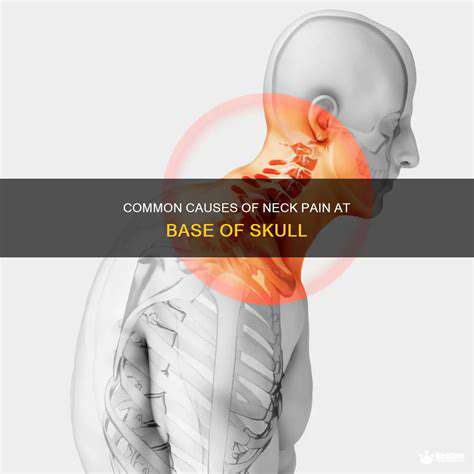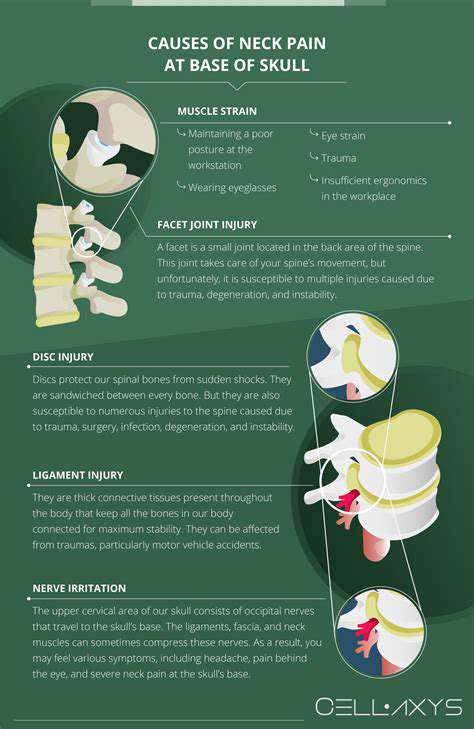Introduction to Pain at the Base of the Skull
Understanding the Causes of Pain at the Base of the Skull
Pain at the base of the skull can arise from a variety of factors, both physical and neurological. One of the most common causes is muscle tension. Poor posture, stress, or prolonged periods of sitting can lead to tightness in the neck and upper back muscles, which may radiate pain towards the skull's base.
Another potential cause is cervical spine disorders. Conditions such as herniated discs or degenerative disc disease can compress nerves and lead to significant discomfort. The cervical spine's alignment is crucial; misalignments can directly contribute to pain and may require professional intervention to correct.
In addition to muscular and spinal issues, headaches can also manifest pain at the base of the skull. Tension headaches, cervicogenic headaches, or migraines often have a referral pain pattern that may be felt in this area. Understanding the type of headache is vital for proper treatment and pain management.
Infections and inflammatory conditions, such as meningitis or occipital neuralgia, can also produce severe pain at the skull's base. These conditions often come with other symptoms, such as fever or sensitivity to light, necessitating immediate medical attention.
Identifying Symptoms and Seeking Remedies
Symptoms of pain at the base of the skull can range from mild discomfort to debilitating pain. Individuals may experience a dull ache, sharp pain, or a throbbing sensation, often accompanied by stiffness in the neck. It is essential to note if pain radiates to other areas, such as the shoulders or arms, as this can indicate more serious conditions.
In the face of this pain, several remedies may provide relief. Over-the-counter pain relievers, such as ibuprofen or acetaminophen, can help alleviate discomfort. However, it is crucial to follow dosage instructions and consult with a healthcare professional for persistent symptoms.
Physical therapy is another effective option for managing pain at the base of the skull. A trained therapist can guide patients through stretches and exercises specifically designed to strengthen neck muscles and improve posture. This holistic approach often addresses the root cause of the problem, rather than just the symptoms.
Finally, lifestyle modifications play a significant role in managing pain. Practicing good ergonomics at work, taking frequent breaks, and incorporating stress-relief techniques such as yoga or meditation can significantly reduce the frequency and intensity of pain episodes.
Common Causes of Pain at the Base of the Skull

Muscle Tension and Strain
Pain at the base of the skull can often be attributed to muscle tension and strain. This discomfort is frequently caused by poor posture, particularly when sitting for long periods or using electronic devices without proper ergonomic support.
The trapezius and suboccipital muscles are commonly affected, leading to a tightness that radiates into the neck and shoulders. While this tension may resolve with rest and gentle stretching, chronic issues can develop if left unaddressed.
Incorporating regular stretches and strengthening exercises can be beneficial. In addition, using ergonomic furniture and maintaining good posture can help alleviate discomfort.
If muscle tension persists, consulting a physical therapist may be useful for personalized treatment plans that can address specific muscle imbalances.
Cervical Spinal Conditions
Another significant cause of pain at the base of the skull is various cervical spinal conditions, such as herniated discs or degenerative disc disease. These conditions can create nerve compression, leading to pain that may radiate into the shoulders and arms.
Symptoms often include a sharp or burning sensation, numbness, and weakness in the upper extremities. It is essential to accurately diagnose the underlying condition through imaging studies like X-rays or MRIs.
Treatment options may vary, ranging from physical therapy and medications to more invasive interventions like injections or surgery. Early detection and appropriate management are crucial for preventing long-term disability.
Identifying Symptoms Associated with Pain at the Base of the Skull

Common Symptoms of Pain at the Base of the Skull
Pain at the base of the skull often comes with a variety of symptoms that can significantly affect daily life. Understanding these symptoms is crucial for proper diagnosis and treatment. Many individuals report tension or tightness in the neck, which may radiate towards the shoulders. This discomfort can also be accompanied by headaches that may vary in intensity and duration.
Another common symptom includes a feeling of heaviness or pressure at the nape of the neck. This sensation often leads to decreased range of motion, making it difficult to turn the head comfortably. Patients may also experience tingling or numbness that extends from the neck into the arms. Such symptoms can be indicative of underlying nerve issues or muscle strain.
It’s important to recognize that not all pain is the same. Some may feel sharp or stabbing, while others might describe it as a dull or throbbing ache. Understanding the type of pain can aid medical professionals in determining the correct cause and providing appropriate treatment.
Moreover, associated symptoms like dizziness, fatigue, or difficulty concentrating can also occur. These symptoms can further complicate the situation, leading to increased stress and anxiety levels as individuals seek relief.
Possible Causes of Pain at the Base of the Skull
There are several potential causes for pain at the base of the skull. One common cause is muscle tension, often resulting from poor posture or prolonged periods of sitting. This muscle strain can lead to inflammation, exacerbating pain in the affected area. Stress and anxiety can also contribute, as they may cause individuals to unconsciously tense their neck muscles.
Another cause might be cervical spine issues, such as herniated discs or degenerative disc disease. These conditions may compress nerves at the base of the skull, leading to pain that can be felt throughout the head and neck. It is crucial to consult with a medical professional if you suspect that spinal issues may be at play.
Tension-type headaches are also a frequent culprit; they can manifest as pain at the base of the skull and are often triggered by stress or poor ergonomics. Identifying lifestyle factors that may contribute can be beneficial in managing this type of discomfort.
Finally, conditions such as migraines or cluster headaches can result in pain that radiates to the base of the skull. These types of headaches typically have other symptoms as well, which can help differentiate them from other sources of pain in that area.
Effective Remedies and Treatments
Understanding the Underlying Causes
Pain at the base of the skull can arise due to various underlying conditions. One common cause is tension headaches, which often result from stress, poor posture, or muscle strain in the neck region. These headaches can manifest as a tight band-like sensation around the head, as well as discomfort at the skull's base.
Another potential cause is occipital neuralgia, where injury or irritation to the occipital nerves leads to sharp, shooting pains at the back of the head. This can occur from conditions such as arthritis, trauma, or even prolonged compression of the neck area, contributing to ongoing discomfort.
Additionally, cervical spine issues, including herniated discs or degenerative disc disease, may lead to pain radiating from the neck to the base of the skull. These conditions can compress nerves in the cervical region, leading to both localized pain and referred pain to adjacent areas.
Identifying the Symptoms
Symptoms associated with pain at the base of the skull can vary based on the underlying cause. Aside from the primary pain, individuals may experience stiffness in the neck, occasional tingling or numbness in the arms, and headaches that can radiate towards the forehead or behind the eyes.
Some people might also report sensitivity to light or sound, as well as fatigue and difficulty concentrating, particularly if the pain is recurrent or chronic. It's essential to keep track of the specific symptoms, as they can help healthcare providers determine the underlying cause and appropriate treatment.
In more severe cases, symptoms such as dizziness, visual disturbances, or balance issues may occur, warranting a prompt medical evaluation to rule out more serious conditions affecting brain function.
Exploring Treatment Options
Effective treatment for pain at the base of the skull often begins with addressing the underlying cause. For instance, physical therapy can help alleviate muscle tension and improve posture, particularly in individuals suffering from tension headaches. Guided exercises can strengthen neck muscles and promote better spinal alignment.
Over-the-counter pain relievers, such as ibuprofen or acetaminophen, may provide temporary relief. However, for more persistent pain, a healthcare provider might recommend prescription medications, muscle relaxants, or anti-inflammatory drugs to manage the symptoms effectively.
Alternative therapies, such as chiropractic adjustments, acupuncture, and massage therapy, have also shown promise in relieving pain at the base of the skull. These techniques can help reduce muscle tension, improve circulation, and promote relaxation, leading to improved overall neck and head comfort.